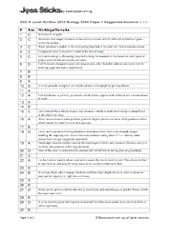Every year, and since time immemorial, it seems that it’s always down to us unfortunate biology students to perform the closing ceremony of the ‘O’ Levels, while others party the weekend away chanting “Bio MCQ? WHAT Bio MCQ?????”
And each year, it’s down to the unfortunately biology tutor (i.e. me) at The Temple to work out the final set of solutions for the season 🙁 (but least this time my brother still has his 100+ comments to go through hur hur):

– click to download (Latest version: 1.1)
In any case,
it’s over!!!
So while all of you now turn your attention to more pressing matters like choosing your prom dress etc., on behalf on all at The Temple, I hope everyone has had a great ‘A’ & ‘O’ Levels and would like to add that nothing else really matters as long as you’ve tried your best, and do take a bit of comfort from this by-now legendary quote over at the H2 Maths Paper 2 post (even though I know the ‘how many marks to get A1?’ Bell Curve fanatics will disagree with this):
… If we require you to swim 100 metres to get the A and you have shown us that you are capable, you will get it regardless of whether a big group of students have proven themselves to be able to swim around the world.
See you all again in January for Judgement Day!
 Last but not least, as my sister is deep in the critical last stage of planning for her annual overseas trip, she asks me to inform everyone of her disappearance from 17-29 November 2010, and that the best way to contact her during this period is through email.
Last but not least, as my sister is deep in the critical last stage of planning for her annual overseas trip, she asks me to inform everyone of her disappearance from 17-29 November 2010, and that the best way to contact her during this period is through email.






 Miss Loi is a full-time private tutor in Singapore specializing in O-Level Maths tuition. Her life’s calling is to eradicate the terrifying LMBFH Syndrome off the face of this planet. For over years she has been a savior to countless students …
Miss Loi is a full-time private tutor in Singapore specializing in O-Level Maths tuition. Her life’s calling is to eradicate the terrifying LMBFH Syndrome off the face of this planet. For over years she has been a savior to countless students … 





















43 Comments
曜
日
my asnwers for bio were CACCC DBBAD AAABC ABDAD CADAA BDBDB ACCCC CADCD
曜
日
Hi miss Loi, I think u uploaded the chem solutions not the pure bio?
曜
日
@James: Should be fine now. You guys are really, really fast! I thought everyone's supposed to be out partying right now? 😛
曜
日
hi for question 16 the explanation is "higher pressure causes the water to move into the capillary" but why is the answer A and not B??
曜
日
@cheese: There's higher pressure outside the capillary and lower pressure inside the capillary. Hence water moves from the outside to inside.
曜
日
For question 28, why is it not the pollen grain?
曜
日
@Fred: @ Fred.
Tube X is the pollen tube. Pollen tube GROWS from the pollen grain (like some sort of "transformation"). So what passes down the tube is like the "content" of the pollen grain, aka gamete.
I got this qn wrong too, shucks :/
曜
日
The answer for question 15 is D. The left ventricle needs to have to a thicker wall than the right ventricle as it has to pump blood to the rest of the body which is a further distance away from the lungs.
曜
日
@Sunil: My dear friend, they asked for incorrect
曜
日
With regards to qns 22, wouldn't the arteriole undergo vasoconstriction, reducing heat loss to surrounding ?
曜
日
@Yip Bing You: I agree with Yip Bing for Question 22 Shoudlnt the arteries undergo vasodilation? :O
And For Qn 18.
Isnt the oxygen used to over come the oxygen debt.
Where Oxygen is used to convert lactic acid to energy
and the energy produced is used to convert lactic acid back to glucose.
Hence, there would be no form of carbon dioxide produced? 🙁
Just my view on the question. Thank you Ms Loi! 😀
曜
日
@Rahdom: Sorry I mean't Constriction*
曜
日
@Rahdom: Guys, I've updated the solutions to version 1.1 to change Q22's answer to B, as a number of you have pointed out. Missed the part where the muscular wall of arteriole #2 contracts, reducing blood flow to the skin surface and thus losing heat to the surroundings.
Regarding Q18, Lactic acid (from anaerobic respiration) that has accumulated in the body is converted to forms that could be oxidised (respiration) and reused to supply the body with energy. Carbon dioxide is produced during such a conversion.
Sorry I was away yesterday. I needed to celebrate the end of my Os too you see 😛
曜
日
@Rahdom: Btw, name's BingYou. Yip is my surname 😉 Selamat Hari Raya Haji to all!
曜
日
For qns 13: they asked: Explanation: energy *NOT* produced by....
Then why is the answer not B? since there is no mitochondria in the sieve tube?
曜
日
@Joanne: Question 13 has to be A because the structure X is poisoned, i.e. respiratory processes are restricted. In normal conditions energy is released by mitrochrondira in companion cells, yes, but when poisoned, it fails to carry out respiration. Therefore, the explaination as to why movement of sugars through the phloem is slowed is due to the companion cells being unable to release energy
曜
日
Regarding question 8, why is the answer not C? I find both B and C equally debatable.. Put C as an answer though.. As for 22, I think the arterioles do go through vasoconstriction.. But maybe they don't exactly have muscles which contract or something.. Not too sure bout that too
曜
日
Isnt Question 2 A??
曜
日
@Victor: Im afraid not.. The first column, "biconcave disc shape to hold extra oxygen molecules" is actually incorrect.. Got tricked too ><
曜
日
@Victor: Question 2 is not A. The biconcave shape of red blood cell increases the speed of diffusion not the amount of O2 it can stored. if u think about it, a biconcave shape stores less red blood cell compared to a normal circular cell.
曜
日
For question 22 Isnt it A??
曜
日
@Victor: Arterioles have thin muscular walls (usually only one to two layers of smooth muscle) and are the primary site of vascular resistance. Thus, question 22 is B, as the muscular walls in the arterioles will cause the arteriole to undergo vascontriction.
曜
日
@Sunil: Vasoconstriction it is! Updated!
曜
日
Thank you so much for uploading the answers!!!
曜
日
With regards to Question 8, the answer should not be B. I don't recall the stomach functioning as a short-term storage organ anywhere in the textbook. The correct answer, I feel, should be D. The rectum is a short-term storage organ (for faeces) and it absorbs water as well. The use of rectal suppositories as a mode of delivery for medicine further proves my point on absorption.
Also, as others have previously mentioned, the answer for Question 22 should be B. Vasoconstriction, which happens when the body temperature is below the norm, is caused by the contraction of the smooth muscles in the arterioles. Ergo, 1 and 2 is correct.
曜
日
@Anonymous: Hi anonymous,
Question 8 cannot be D. Absorption of water occurs at the colon. D shows the rectum, not colon. While yes it temporarily "Stores" faeces, absorption does not occur there at all.
And yes question 8 i find B and C both equally debatable. My textbook did wrote "the stomach temporarily stores food for 3-4 hours", but then assimilation i thought can also occur in the small intestine (According to Wikipedia as well as the GCE O Level Biology syllabus)? Food is "transported" from the small intestine, and can also be "utilized" by the small intestine e.g. Glucose for intestinal respiration?
Correct?
Thanks!
曜
日
@James: With regards to option D, I am afraid you may be right. Upon further research, I found out that the rectum actually pushes material back into the colon for absorption of water if you do not defecate. Ah, there goes one mark. Oh well, no use crying over spilled milk.
As for option C, that is an interesting point that you brought up there. We might need an expert's opinion on this particular question, preferably from Cambridge.
曜
日
@James: Yup.. Did my research too, both B and C are logical.. Hope the answer's C though =x
曜
日
@James: Q8, I believe, is about the main functions of the parts along the alimentary canal.
The small intestine in C is mainly used for digestion and absorption. On the other hand, assimilation refers to the conversion of absorbed food into the substance of the body (occurring in almost all respiring cells).
曜
日
@Little Miss Loi: Haha then in that case "temporary-storage" is also not the main function of stomach, I suppose? Cos I was thinking if stomach can temporarily store food, technically other parts of the gut also "stores food", like staying there for a while eg food stays in small intestine for a while too? Hmmm Cambridge sure is tricky....
曜
日
Structure 2, which are arterioles, do have muscles that can constrict but the question asks for muscles that constrict when body is too cold. If Structure 2 were to constrict then more blood would flow to the arterioles near the skin surface due to increased blood pressure which could cause more heat loss through the skin. In this case the most appropriate answer is 1 only. @anonymous the stomach can be said to function as a storage organ as it churns food and holds food until it is fully distended, whereby it gives signals to the brain to relax the pyloric sphincter. On page 94 of Biology matters, one can find that the stomach 'is able to store food for hours'
曜
日
@pooh: @pooh
Your concept on vasoconstriction is wrong. Read the textbook. Vasoconstriction means less blood flows to to blood capillaries in the skin, decreasing heat loss, i.e. Structure 2 should be included in the answer.
As for Question 8, it really is up to Cambridge on what they view is the right answer. Both options B and D can be justified, but only one can be the correct answer. Oh well.
曜
日
@pooh: To add on to Anonymous' reply, the difference in blood pressure is observed when a comparison between artery (smaller lumen, higher blood pressure) and vein (larger lumen, lower blood pressure) is made. Artery does not constrict itself for the purpose of increasing blood flow or blood pressure. Rather, increased body fluid intake or salt intake (which leads to subsequent water re-absorption) would lead to an increase of blood pressure.
Anyway, as mentioned, I've amended Q22 to B.
曜
日
For question 18 i believe that answer should be C, 2 only as from S-T the exercise has ended, which would mean that CO2 is being sent back at normal pre-exercise levels. The increased blood flow only serves three key purposes: to increase oxygen supply to muscle cells and to send lactic acid to liver to be oxidised, and to remove excess heat due to exercise.
曜
日
Hey, are marks above 85 a possible A1 for bio? A1 cannot be as ridiculous as 90 right?
曜
日
It seems that many people got q22 wrong. i got it wrong too.. i put B. 🙁 could anyone explain why its A?
曜
日
@hmmm...: Q22 should indeed be B. Just updated my solutions 😛
曜
日
shouldnt the ans to 24 be B? reading from the book which has the skeleton picture as its cover, in page 280 it says ciliary muscles contract,relaxing the suspensory ligaments. when it slacken, it pulls the lens,making it thicker,more elastic and convex decreasing its focal length, and light rays from th near object are sharply focused on the retina..
曜
日
@wierd: They ask what controls the movement of eyeball that helps control light falling on the retina, which is the rectus muscle. First page of bio matters says so.
曜
日
a level chem mcq answers please? (:
曜
日
wow...u do make bio alot more easier to understand!i find the structure of spinal nerve VERY difficult and it would be very helpful if u explain it!
曜
日
is it possible to get A2 for bio if i got 32/40 for this paper??
🙁
gd luck on monday everyone hope all pure bio students get A1 and crash the bellcurve! 🙂
曜
日
nice effort Miss Loi <3